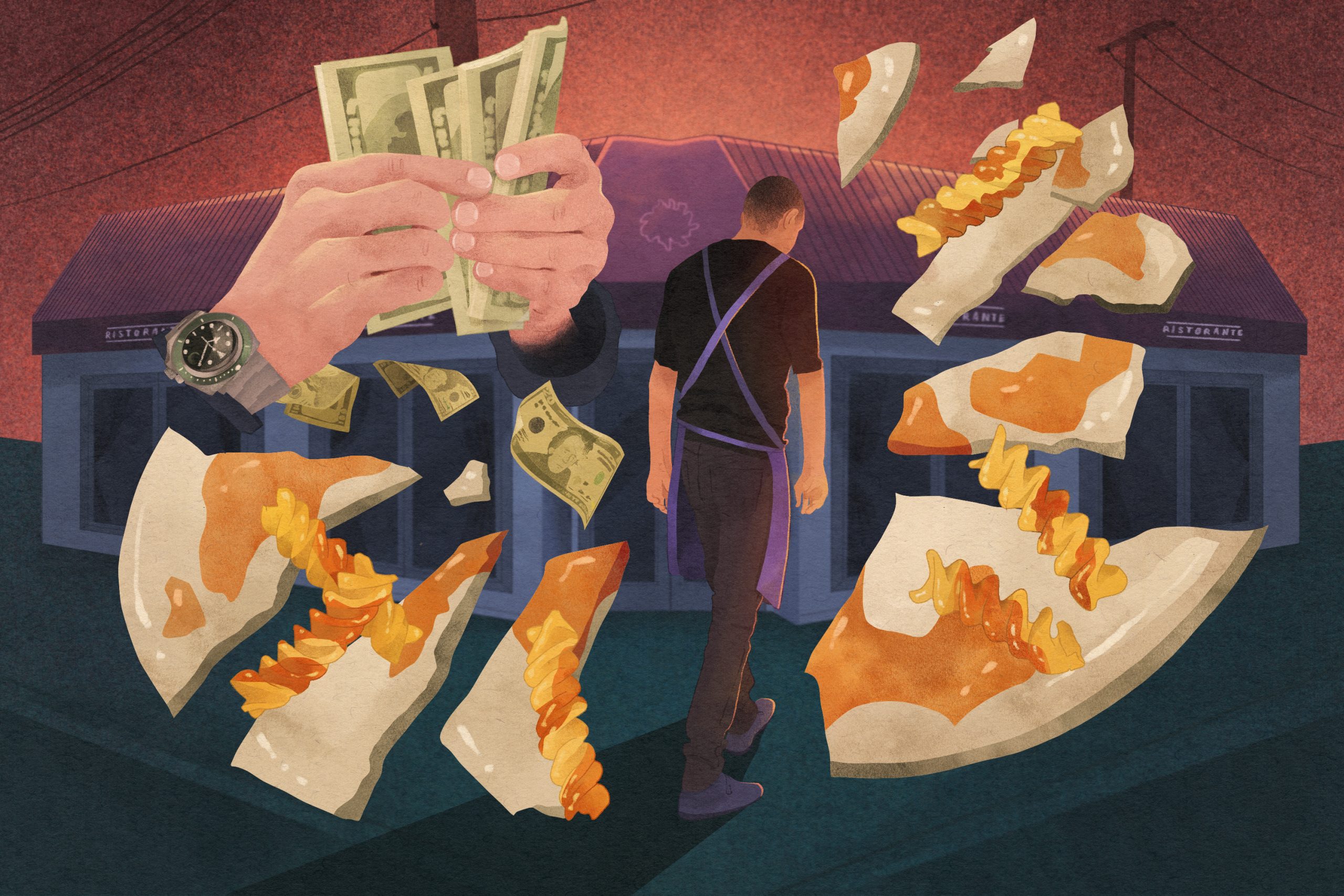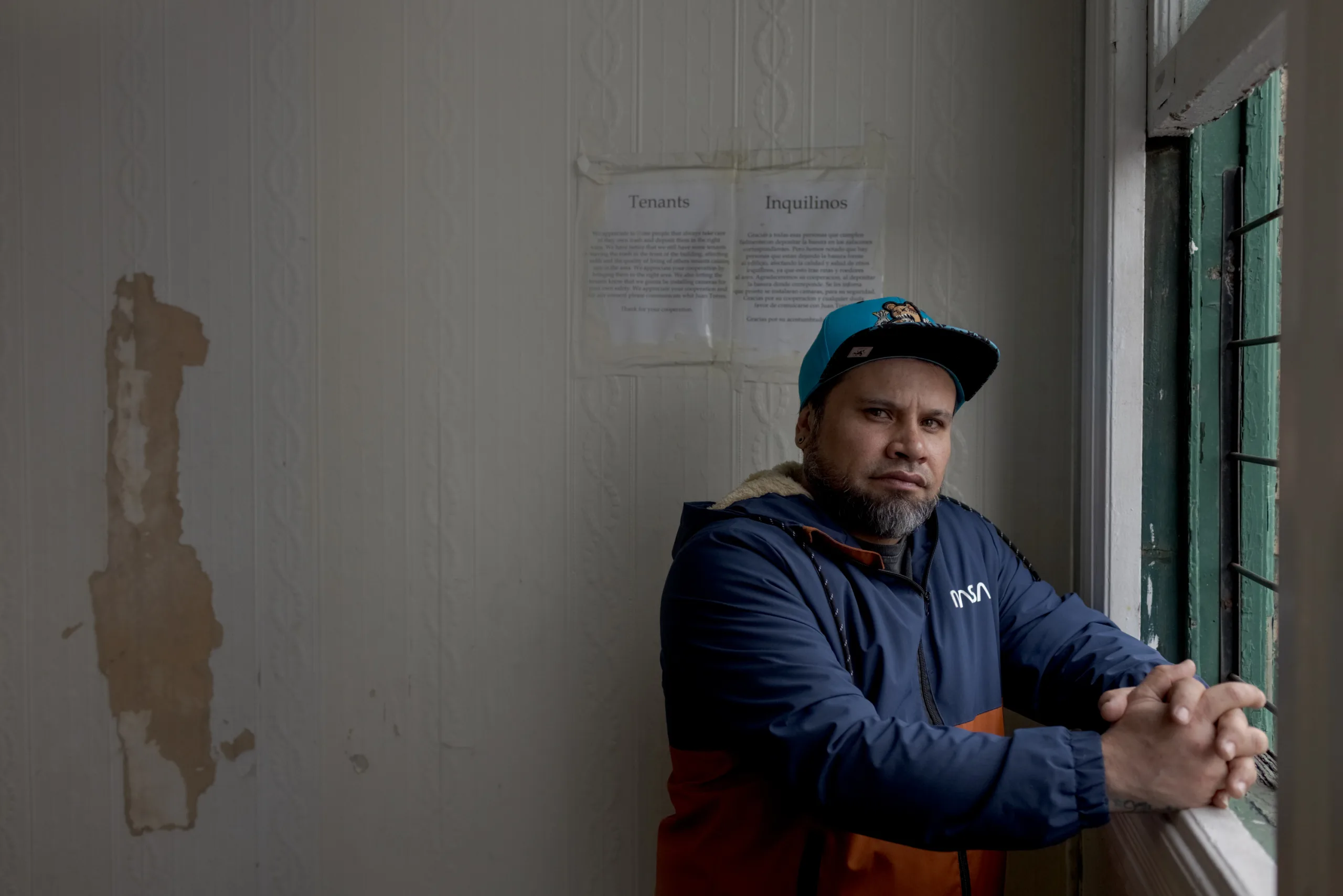This article was produced for ProPublica’s Local Reporting Network. Sign up for Early Arrival to get stories like this one as soon as they are published.
For Marcelino Zapoteco, the final straw came on a quiet night in 2018 at the restaurant Brioso on Staten Island. He was working alongside one of the managers who had been pulled in by the restaurant’s co-owner Pietro “Peter” DiMaggio to help as a waiter. At one point during the shift, Zapoteco watched the manager slip tip money into his pocket, when he was supposed to pool it to be shared with others.
Zapoteco, an undocumented immigrant from Mexico, said he knew that the restaurant was grossly underpaying him during the more than seven years he worked there. When he served as a runner, bringing food to customers’ tables, he received as little as $10 for lunch and dinner shifts — far below the required minimum wage even when tips were included, he said.
Also Read: NYS Department of Labor Fails to Recover $79 Million in Stolen Wages
But that night, when he saw the manager pocketing the tip, Zapoteco had enough. A few days later, he and his co-workers went to DiMaggio and complained — but to no avail. “If you guys don’t like me or don’t like Brioso, the door is over there,” DiMaggio told them, according to a state investigator’s report, which included a transcript of a recording of that conversation.
Zapoteco quit and made his way to the offices of the New York State Department of Labor in Manhattan the next day, telling an investigator about what happened.
“I explained to her everything that was going on. She said: ‘Don’t worry. We’re going to investigate,’” Zapoteco said. “‘We’re going to help you.’”
Every year in New York state, thousands of workers face predicaments similar to that of Zapoteco and his former Brioso co-workers. From 2017 through 2021, federal and state investigators found more than 13,000 cases of wage theft, according to an analysis of two databases obtained from the U.S. and New York Labor departments. The databases provide previously unreported details on how much money has been stolen from workers and also shed light on which businesses have committed wage theft.
In all, federal and state investigators determined during the five-year period that more than $203 million in wages had been stolen from about 127,000 workers in New York, the analysis shows.
The amount of wage theft is almost certainly a significant undercount, according to the U.S. Department of Labor. In 2014, for instance, the agency analyzed census and employment data to compare the reported wages of New York workers against what they should make under local minimum wage, and it estimated that state employers steal up to $1 billion from their workers every year.
Federal and state investigators determined that more than $52 million had been stolen from people working in restaurants, more than in any other industry in New York, accounting for more than 25% of all reported wage theft, the analysis shows.
Wage theft was also a problem in the health care industry ($28.4 million); construction ($27.6 million); janitorial services and retail stores ($5.9 million each); and supermarkets and convenience stores ($5.8 million).
State-to-state comparisons of wage theft are difficult because of how data is collected locally. But an analysis of cases reported to the U.S. Department of Labor and substantiated by federal investigators shows that New York ranked eighth highest in the amount of back wages owed per worker.
Advocates say that the federal and state agencies are failing to stamp out wage theft, and that they have little faith in the agencies’ ability to protect workers’ livelihoods.
“Wage theft is not taken seriously as a crime by this system, by the New York state law enforcement groups or the elected leaders of our state,” said JoAnn Lum, executive director of the National Mobilization Against Sweatshops, a New York-based workers’ rights organization. “How are working people who are working so hard expected to survive if it’s OK to have their wages stolen?”
Hildalyn Colón Hernández, deputy director of New Immigrant Community Empowerment, a New York-based worker advocacy organization, said, “Employers are operating with no consequences.” One of the reasons, she said, is that the federal and state agencies haven’t fully adapted to the changing business landscape — with technology and the so-called gig economy complicating the employer-employee relationship — that makes wage theft even harder to address.
Colón Hernández added that her organization now trains its employees on how to investigate wage theft because it would take too long if they had to rely on federal or state investigators to recover back wages.
The U.S. Department of Labor did not respond to requests for comment.
Aaron Cagwin, spokesperson for the state Department of Labor, highlighted his agency’s work with the Wage Theft Task Force, a collaboration with the state attorney general’s office and other law enforcement agencies that began in 2015. Last year, Gov. Kathy Hochul announced that the task force had secured felony convictions of nine employers for a variety of charges, from defrauding the New York State Insurance Fund to falsifying business records and failing to pay wages.
Cagwin said his agency uses “every resource available to protect New Yorkers, ensure workers are paid what they’re owed and hold bad actors accountable.”
Frank A. Oswald, a lawyer for the owners of Brioso, said his clients disputed the wage theft allegations made by Zapoteco and other former workers. He noted that the owners eventually agreed to settle the civil lawsuit that the former workers filed against them, and that was because of the Chapter 11 bankruptcy that the restaurant filed “due to the exorbitant costs of the wage litigation in the District Court that threatened to put the restaurant out of business.”
In 2018, a lawyer representing the Brioso owners at the time also wrote to a state investigator claiming that Zapoteco quit his job not because of wage theft but because of a disagreement over payment method. Zapoteco, the lawyer wrote, insisted on being paid in cash, instead of through an automatic payroll system. Zapoteco denied the allegation.
Zapoteco moved to New York City from the Mexican state of Guerrero in 2009 in search of work and education opportunities. A year later, he began working at Brioso after a cousin who had been living in the city told him about the job. Zapoteco became a busser, taking dirty plates to the kitchen. He was soon promoted to runner after a worker in that role quit.
Throughout his time at the restaurant, Zapoteco said, he experienced wage theft. Carlos Ortiz, a state investigator assigned to the case, detailed in reports obtained by Documented and ProPublica a number of ways DiMaggio stole money from his workers: DiMaggio deducted 5% of their tips “supposedly to pay for the computer system” and sometimes took more in certain circumstances, such as when customers complained about their food — a form of wage theft under New York law. Ortiz also found that DiMaggio made some workers buy uniforms and pay for broken plates — another form of wage theft.
Labor experts say wage theft is prevalent in the restaurant industry because its workforce is heavily made up of undocumented immigrants, who are less willing to speak up because of their status.
More than 60% of restaurant workers living in New York City are immigrants, according to a 2020 study by the New York state comptroller’s office. Of the 317,800 workers in the industry, 44% were Hispanic and 20% were Asian, the study found.
At Brioso, Ortiz found that the workers’ immigration status left them exposed. When one employee complained about stolen tips, for instance, DiMaggio responded by threatening to report the employee to the immigration authorities, slamming tables and then firing him.
“Mr. DiMaggio would make statements to the Hispanic employees, such as, ‘I’ll personally make sure that you all get sent back to Mexico,’ or, ‘Thank god that Trump is doing everything possible to get you guys the fuck out of here,’” Ortiz wrote.
In New York, the state’s minimum wage rules can also work against restaurant employees. The normal rate is $14.20 to $15 an hour, but it’s $9.45 to $10 for food service workers — with a requirement for their employers to make up the rest if tips don’t cover the difference. This creates a complex system that makes it easy to exploit workers, said Teofilo Reyes, chief program officer for Restaurant Opportunity Center United, a national organization advocating for better pay and working conditions for restaurant workers.
Elizabeth Joynes Jordan, co-legal director at Make the Road New York, an immigrant-rights organization, said wage theft is essentially “the business model” for restaurants.
Some places are exploring banning the two-tiered minimum wage system entirely. Washington, D.C., for instance, voted in November to phase out the system by 2027. But no similar measures have been adopted in New York.
Like restaurant employees, experts say, construction workers in New York often experience wage theft, given that the industry also employs a high number of undocumented immigrants.
About 1,600 construction companies — including ones that specialize in carpentry, electrical work and iron work, as well as general contractors — were found to have stolen wages from more than 7,700 New York workers from 2017 through 2021, the analysis shows.
Health care workers, including nurses and employees at hospitals and nursing homes, faced about as much wage theft as construction workers, the analysis shows.
Lum of National Mobilization Against Sweatshops said the unique working conditions of many health care workers make them vulnerable to wage theft. For instance, home health care aides, who had the highest amount of wage theft found by federal and state investigators among all professions in the industry, often have to work 24-hour shifts but are not paid for breaks built into the schedule for eating and sleeping. Lum said this payment structure rarely reflects the reality that patients need care at odd hours of the night, meaning workers are on call continuously.
“When they try to report that they don’t sleep, then they’re ignored and retaliated against, or even punished,” Lum said.
Some members of the National Mobilization Against Sweatshops were involved in arbitration claims filed in 2019 against 42 home health care companies alleging that they underpaid more than 100,000 workers in New York. In February, an arbitrator awarded a $30 million fund, paid for by the companies, to compensate the workers.
Some workers are unhappy with this outcome and say they are owed as much as $6 billion. Lum said the arbitrator’s ruling amounts to a slap on the wrist for the companies. “It sends a message to the employers that you can continue doing what you’re doing,” she said.
In September 2018, seven months after Zapoteco quit his job and went to the New York State Department of Labor, the agency’s investigators visited the restaurant and interviewed several workers. Several months later, as the investigation continued, a Brioso employee called Ortiz, complaining that he and his co-workers had been subjected to retaliatory actions by DiMaggio.
The employee “alleges that Mr. DiMaggio has always yelled at and intimidated the employees, but has become more aggressive since the Department’s visit,” Ortiz later wrote in his report.
The agency eventually reached out to Make the Road New York to see if it could help protect the workers.
Joynes Jordan said Make the Road took on the case after learning that it was “one of the worst cases in terms of conditions that we’ve seen.”
Cagwin, the Labor Department spokesperson, said his agency was able to build “a thorough case” in October 2019 and turned it over to the Richmond County District Attorney’s Office, which handles cases on Staten Island.
Criminal convictions for wage theft are rare, but the district attorney’s office initially expressed interest in pursuing the case, Joynes Jordan said.
The district attorney’s office interviewed several Brioso workers, and in March 2020 a waiter was scheduled to appear before a judge in order to get a search warrant for the restaurant’s computers. But then COVID-19 hit, and his testimony was canceled.
When Make the Road lawyers followed up three months later, the district attorney’s office told them that it needed more information. “We were informed the information they had gotten from our clients was stale at that point,” Joynes Jordan said.
James Clinton, a community liaison for the district attorney’s office, declined to comment.
Meanwhile, concurrently with the criminal investigation by the district attorney’s office, the Department of Labor investigators were still working to recover back wages from Brioso. But Zapoteco and his former co-workers had heard nothing from them. With the case dragging on, Make the Road lawyers and a pro bono partner asked the agency to close the case so that the findings from its investigation could be shared with them and used in a federal civil lawsuit they were planning to file on behalf of the workers. They filed the lawsuit in December 2020, demanding more than $12 million.
During the lawsuit’s discovery process, lawyers found that Brioso had two previous wage theft claims against it: one from a decade earlier in which the agency ordered Brioso to pay a worker more than $12,000, and another from 2017 that it settled for $75,000.
In November, the owners of Brioso agreed to settle the lawsuit with Zapoteco and 11 others for $700,000, with roughly a third of it covering the lawyers’ fees.
In May, roughly five years after he went to the New York State Department of Labor, Zapoteco received his payment from Brioso. But he said he was frustrated with the experience of working with the agency, saying it “doesn’t work well because it took so long — we were waiting forever.”
Zapoteco said neither the agency nor the district attorney’s office was able to hold DiMaggio accountable for what he did. “I wanted him to fix the way he was doing things,” he said.
About the Data
To examine the prevalence of wage theft in New York state, Documented and ProPublica analyzed federal and state databases of labor violations obtained from the U.S. and New York Labor departments.
Documented filed a public records request for the state database in 2019. When the New York State Department of Labor refused to release it, Documented took the agency to court. The agency has since released to Documented and ProPublica its internal database containing information on nearly 97,000 cases that began and concluded from 2005 to Feb. 21, 2023. But the database only provides the dates of when cases began, so we focused our analysis on cases from 2017 to 2021.
For the federal database, we couldn’t use exactly the same time frame because it does not contain information about when cases were opened and closed. Instead, it provides a date when the findings in the case occurred. To try and match up the periods analyzed for both federal and state databases, we focused on the 4,900 cases with dates of findings from 2017 to 2021.
Both federal and state databases provide a number of details on each case, including the names and addresses of businesses that committed the violation, the number of workers who were affected and cited labor law violations.
For the state comparisons, we used the federal database to tally the number of wage theft cases and the amount of back wages owed in each state and then adjusted them using labor force size data from the U.S. Bureau of Labor Statistics.
For the industry comparisons, we manually reviewed the industry codes included in both databases and grouped them into larger categories, such as restaurants, construction and health care.
Data analysis by Agnel Philip, ProPublica, and Lam Thuy Vo, special to ProPublica















